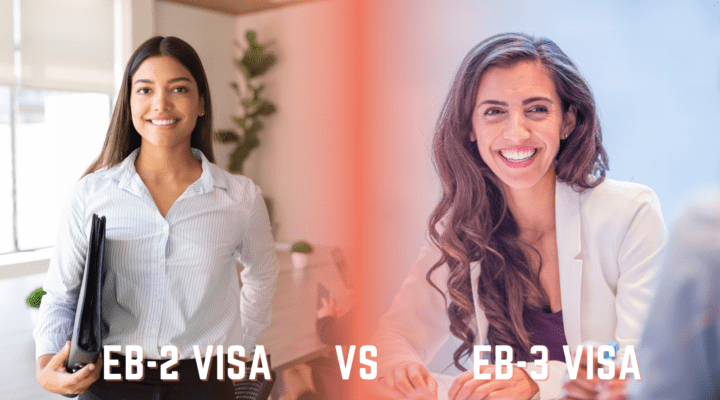The EB-2 and EB-3 are two types of Employment-Based green card categories. The United States Citizenship and Immigration Services (USCIS) grants these visas to foreign nationals who meet the requirements, depending on their degrees, professional skills, and country of origin. Before selecting the right one for you, it’s important to compare and contrast the different options available. On this page, you will learn about the differences between EB-2 vs EB-3, including the requirements, processing times, and which one is better for you.
Introduction to EB-2 and EB-3 Green Cards
EB-2 or EB-3 green cards entitle foreign workers to live and work permanently in the U.S. through employment. Both options require sponsorship from a willing employer and enable foreigners to pursue citizenship after five years.
The EB-2 and EB-3 preference categories were created by the Immigration Act of 1990, which established a combined annual cap of 140,000 employment-based green cards across all five employment-based categories, including dependents.
Overall, the U.S. seeks to admit residents who can provide economic and societal advantages to the country. As such, future residents must meet specific requirements set out by USCIS. Specific to the EB-2 and EB-3, this includes:
- advanced degree professionals
- those with “exceptional ability”
- skilled workers
- professionals
- and unskilled workers (other workers).
Our lawyers have an exceptional track record of securing approvals! Learn more in this EB-2 visa approval guide!
EB-2 vs EB-3: Key Differences in Employment Classification
There are many potential pathways available to foreigners seeking to enter the US through an employment-based green card. EB-2 and EB-3 are the most popular in terms of the number of new applications. It is crucial to know the differences between the two.
|
|
EB-2 (Second Preference) |
EB-3 (Third Preference) |
|
Who It's For |
Workers with Advanced Degrees or Exceptional Ability |
Skilled Workers, Professionals, and Other Workers |
|
Minimum Education |
Master's degree, or Bachelor's degree + 5 years of progressive experience. |
Bachelor's degree (for Professionals subcategory). |
|
Minimum Experience |
5 years of post-bachelor's experience (if no Master's). |
2 years of experience or training (for Skilled Workers subcategory). |
|
Labor Certification Waiver |
Possible through a National Interest Waiver (NIW), allowing self-petition. |
Not possible. A job offer and PERM labor certification are always required. |
|
Typical Visa Wait Time |
Generally shorter wait times due to higher requirements and lower volume. |
Often longer wait times, especially for the "Other Workers" subcategory. |
Requirements
The main difference between EB-2 vs EB-3 is that the EB-3 requirements offer more flexibility and are more lenient compared to the EB-2, so more people qualify for it.
EB-2 candidates typically have an advanced (master’s or doctorate) degree. Alternatively, they may qualify without an advanced degree if they have a bachelor’s degree and 5 years or more of progressive experience in their field.
In contrast, the EB-3 requirements depend on which of the different subcategories you fall under:
You may be eligible for one of these immigrant visa preference subcategories if you fall into one of the following categories:
- EB-3A: “Skilled workers” are persons whose job requires a minimum of 2 years of training or work experience, not of a temporary or seasonal nature.
- EB-3B: “Professionals” are persons whose job requires at least a U.S. baccalaureate degree or a foreign equivalent and are a member of the professions.
- EB-3C: The “other workers” subcategory is for persons performing unskilled labor requiring less than 2 years of training or experience, not of a temporary or seasonal nature.
In some cases, candidates can obtain EB-2 and EB-3 green cards without these requirements. Nevertheless, applicants should know that they are competing against other applicants who do possess the education and work experiences listed above.

Timeline
While the processing times for the PERM labor certification process and I-140 petition are similar between the EB-2 and EB-3, the final action dates can differ drastically.
Generally, the EB-2 has more favorable wait times than the EB-3. However, in recent years, surges in EB-2 petitions from high-volume countries have created large backlogs in the EB-2 category, occasionally making the EB-3 a faster option for specific countries.
The EB-3 Other Workers subcategory is almost always the slowest of all the employment-based categories. Because it has the least difficult requirements, it is subject to greater demand and a very limited annual visa supply.
Differences Between EB-1, EB-2, EB-3, EB-4, and EB-5 Categories
Five employment-based categories grant you permanent residency in the U.S. The category you decide on should depend on your qualifications, studies, and skills.
The EB-1 green card tends to be the most difficult to obtain, yet it has the fastest processing time because there are fewer steps in the verification process. EB-2 and EB-3 categories require more thorough documentation, longer screenings, and increased wait times. However, more applicants are qualified for EB-2 and EB-3 green cards than any other category listed here.
EB-4 and EB-5 are special cases; the former is reserved for religious workers while the latter is reserved for investors. Each of the five classifications is covered in more detail below.
- EB-1 – Priority Workers. This includes Nobel prize winners, Pulitzer prize winners, Olympians and other award winners. Generally, this is a difficult category to have approved. Since they are held in such high esteem, EB-1 workers do not need a job offer in order to be considered for a visa.
- EB-2 – Professionals with exceptional ability. A formal job offer from an employer is needed to enter the U.S. under this category. EB-2 workers hold advanced degrees and specialized knowledge in fields such as medicine, engineering, energy, leadership, and business.
- EB-3 – Skilled or Professional Workers. EB-3 candidates are those that hold a minimum of a Bachelor’s degree and have at least 5 years of experience. The EB-3 requirements are less stringent but the backlog is much longer as a result. Therefore the processing time for an EB-3 may be several years longer than that of an EB-2.
- EB-4 – Religious Workers. These non-profit workers are usually affiliated with churches, synagogues, mosques, or other religious organizations. While in the U.S., they can only work for these institutions. You may also qualify if you are a:
- Special Immigrant Juvenile
- Broadcaster
- G-4 International Organization or NATO-6 Employee
- International Employee of the U.S. Government Abroad
- Armed Forces Member
- Panama Canal Zone Employee
- Specific kinds of Physicians
- Afghan or Iraqi translator
- Afghan or Iraqi national who has provided faith service in support of U.S. operations.
- EB-5 – Investors. One of the most expensive paths to qualify for, the EB-5 category is reserved for investors that must invest at least $1 million into a U.S. enterprise. Investors need to hire 10 American workers and work in conjunction with the US Department of Labor. If the business succeeds at the end of a 2-year review period, the investor is given a residential visa.
Check out our answers to the most frequent questions about the EB-2 to EB-3 India Downgrade
Differences Related To Employer Eligibility
Employers need to work closely with the USCIS and the United States Department of Labor (DOL) to demonstrate they to demonstrate that offering you this role will not impact the wages and working conditions of similarly employed U.S. workers.
When an employer wants to sponsor you for an EB-2 or EB-3 green card, they must follow several steps:
- Advertise for the job in a newspaper of wide distribution for at least 2 Sundays. Depending on the role, they may also need to advertise the job position in 3 other recruitment forms, such as websites, across a college campus, or job boards.
- Advertise with the State Workforce Agency for 30 days where the employee will be working.
- Document the recruitment process, including all applicants that have applied for the job, as well as all efforts to vett each applicant. You do not need to interview everyone who sends in a resume, but you do need to make efforts to show you gave all qualified applicants a fair chance.
- File a Labor Certification Application (PERM) with the DOL. Your business will need attest that they will pay the prevailing wage and will not displace current U.S. workers.
- File I-140, Petition for Alien Worker.
- Wait for the EB-2 or EB-3 visa to become available.
How to Reduce EB-2 and EB-3 Processing Time
Once these steps are complete, your employer may elect to use premium processing. This feature reduces I-140 processing time to 15 business days for an additional cost of $2,805, which must be paid out to immigration authorities.
In some cases, premium processing may be worth the investment in order to cut wait times. However, keep in mind that applicants will still need to wait in queue for their EB-2 or EB-3 green cards. More on that in the section below.
EB-2 and EB-3 Priority Dates
Your priority date is the date on which the USCIS receives your PERM Labor Certification petition. Because there is a limit to how many immigrant visas are provided each year, some visa preference levels have developed a significant backlog.
Each month, the Department of State (DOS) releases a Visa Bulletin that is designed to inform applicants what the current filing dates are. When the filing date matches your priority date, you can file your I-485. When the final action dates match your priority data, a visa will become available for you. The posted filing and final action dates vary according to your country of origin.
The Visa Bulletin provides the most recent date for when a visa number is available for the different categories and countries for family-sponsored, employment-based, and diversity (lottery) visas and categories.
EB-3 to EB-2 Porting
Due to the drastically reduced wait time concerning priority dates, many applicants attempt to transfer their EB-3 petition to the EB-2 category.
This, however, will require you to obtain a new position with the same or a different employer that is substantially more complex than your original job. It also may require an advanced degree or five years of experience on top of your bachelor’s degree.
If you can secure such a position, then you can have your employer file for another PERM Labor Certification for your new position. Once that has been done, your employer can then file a new I-140 petition and request to have the old priority date retained.
Because this process can easily be complicated and delicate, it is important to retain the services of a qualified immigration attorney to help make sure that the process goes as smoothly as possible.
Key Takeaway
You should review the process carefully to determine the most appropriate option. An honest assessment of your schooling, skills, and years of relevant industry experience will help decide which category is best for you.
Find out the minimum requirements for employers and employees by working with a qualified immigration attorney. That way, you’ll be able to showcase yourself in the best light when you are being considered for a green card.









